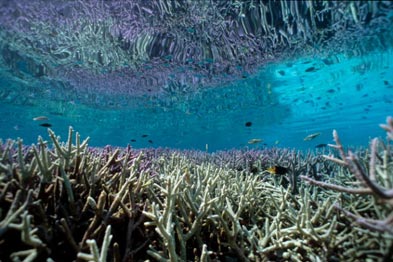Discoveries
Organ Pipe Coral Flourishes at Long Reef
New discovery
Dr Zoe Richards & Dr Monika Schlacher-Hoenlinger
One notable discovery at Long Reef was a fore-reef ramp on the western side of the reef (Site 56 - 13°95’70”S, 125°71’85”E) dominated by the Organ Pipe Coral of the genus Tubipora (family Tubiporidae) (see Figures 1 and 2). There are several nominal species of Tubipora based on the gross skeletons, and further investigations are necessary to confirm the species. Nevertheless, Tubipora is the only known hard, calcitic, reef-building alcyonarian (soft) coral. Its skeleton consists of calcite spicules fused into upright, parallel tubes connected by transverse platforms.
During the spring low tide of the 24th October 2010, six 10 m long point intercepts were conducted in the shallow fore-reef ramp habitat zone to quantify the benthic coverage of this, yet unknown species of Tubipora. The mean coverage was 27.67% (+3.24 SE), thus verifying Tubipora as the dominant benthic organism in the zone. Turf algae (22% + 5.49 SE); sand/rubble (18% + 4.26SE); and coralline algae (9% + 2.5 SE) inhabited the majority of the remaining space. Another ten genera of hard corals were recorded on transects within this habitat, however their combined coverage was <20%.
The skeleton of organ pipe coral is distinctive because of its bright red colour. The red colouration is a result of organic pigments, including carotenoids, which give the bright orange colour to carrots and the red colour to cooked lobsters. Carotenoids occur naturally in plants but are not manufactured by animals, so it is likely the organ pipe coral assimilates the pigments via feeding on phytoplankton. Incorporating pigment into the skeleton is likely to serve the coral in two ways: firstly, it would help light absorption for use by symbiotic dinoflagellates in photosynthesis; and secondly, it helps protect chlorophyll from photodamage (Cvejic et al., 2007).
Organ pipe coral is not thought to cover large areas and it appears to be normally sporadic to rare in abundance. Tubipora has been observed in large quantities near Rat Island off Gladstone in Queensland, Australia (Philip Alderslade pers. comm.). A preliminary literature search revealed the highest published estimate of Tubipora musica as 11.9% from one location in the Red Sea (Benahayu and Loya, 1977). Hence, the level of coverage recorded at Long Reef could be exceptionally rare. Due to its attractive bright red skeleton, organ pipe corals are collected for the curio, jewellery and aquarium trade and so management may be required for the species and close attention should be paid to monitoring the effects of harvesting (Obura et al., 2010).

- Figure 1 and 2. Tubipora sp. dominates a narrow band of fore-reef habitat on the western side of Long Reef, Eastern Kimberleys.
- Photos by Dr. Monika Schlacher-Hoenlinger.
- Image copyright of Queensland Museum
Benayahu, Y. & Loya, Y. 1977. Space partitioning by stony corals soft corals and benthic algae on the coral reefs of the northern Gulf of Eilat (Red Sea) Helgol~inder wiss. Meeresunters. 30, 362-382
Cvejic, J., Tambutte, S., Lotto, S., Mikov, M., Slacanin, I and Allemand, D. Determination of canthaxanthin in the red coral (Corallium rubrum) from Marseille by HPLC combined with UV and MS detection. Mar Biol 152:855-862.
Obura, D., Fenner, D., Hoeksema, B., Devantier, L. & Sheppard, C. 2008. Tubipora musica. In: IUCN 2010. IUCN Red List of Threatened Species. Version 2010.4. www.iucnredlist.org.







